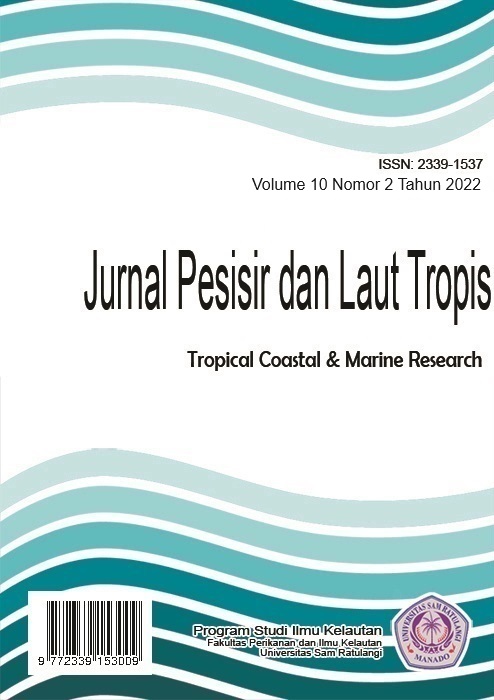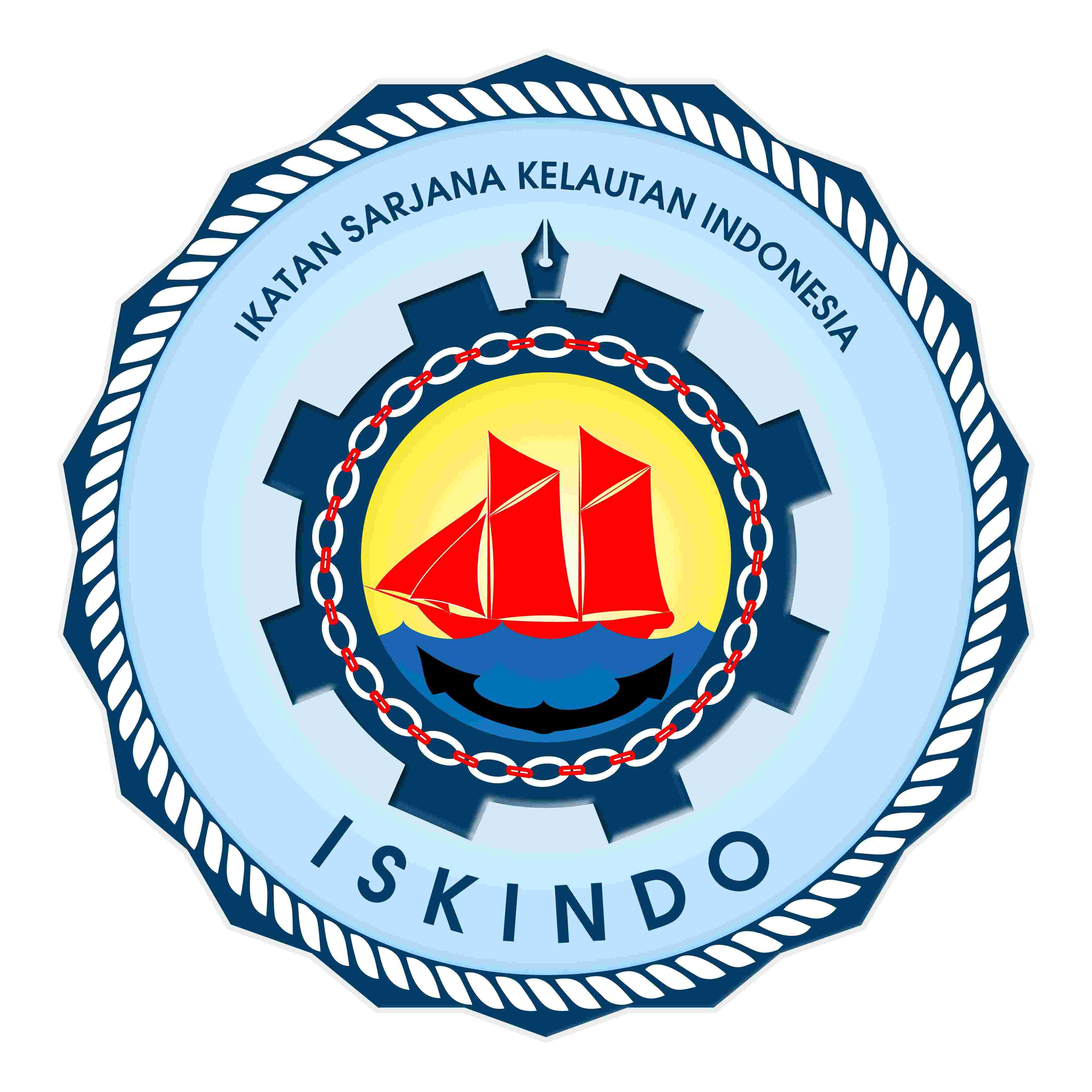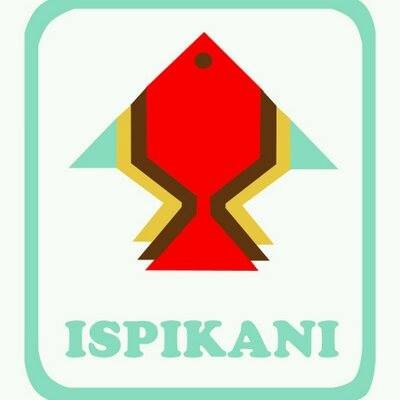UJI TOKSISITAS SOFTCORAL Lobophytum Sp. TERHADAP UDANG Artemia salina, L MENGGUNAKAN METODE BRINE SHRIMP LETHALITY
DOI:
https://doi.org/10.35800/jplt.10.2.2022.54984Keywords:
Karang lunak; Lobophytum sp.; anti kanker; Artemia salinaAbstract
Marine biota resources as a potential asset that can be used into various products including pharmaceutical products because they were a natural ingredient that very rich in biologically active compounds with a unique structure. Softcoral Lobophytum is one of the marine biota that has the secondary metabolites which can be useful in pharmacology field. The purpose of this study is to test the toxicity of the soft coral extract of Lobophytum sp as an anti-cancer biopotential. This research is using the Brine Shrime Lethality Test (BSLT) method, with laboratory experiments. Solfcoral samples were taken from Bunaken Island that using purposive sampling method. The test concentrations using 10, 100, 500 and 1000 ppm. The analysis toxicity using probit analysis for minitab program. The results showed that the increasing of concentration was followed by the increasing of the mortality number of the animal testing. The results of probit analysis obtained an LC50 value of 9.98 ppm. These results indicate that the bioactive substance of softcoral Lobophytum sp has the potential as an anti-cancer compound.
Keywords: Soft coral, Lobophytum sp, anti cancer, Artemia salina
ABSTRAK
Sumber daya biota laut merupakan aset potensial yang dapat digunakan menjadi aneka produk termasuk di antaranya produk farmasi karena merupakan bahan alam yang sangat kaya senyawa aktif biologi dengan struktur yang unik. Softcoral Lobophytum salah satu biota laut yang memiliki metabloit sekunder yang dapat bermanfaat dalam bidang farmakologi. Tujuan dari penelitian ini bertujuan untuk menguji toksisitas ekstrak karang lunak Lobophytun sp sebegai biopotensi antikanker. Metode penelitiaan digunakan yaitu metode Brine Shrime Lethality Tes (BSLT), dengan percobaan laboratorium. Sampel solfcoral diambil dari pulau Bunaken, pengambilan sampel menggunakan metode purposive sampling. Konsentrasi uji menggunakan 10, 100, 500 dan 1000 ppm. Analisis Toksisitas menggunakan analisis probit dengan menggunakan program minitab. Hasil yang diperoleh menunjukan setiap bahwa setiap kenaikan konsentrasi diikuti dengan kenaikan jumlah mortalitas hewan uji. Hasil analisis probit diperoleh nilai LC50 9.98 mg/l. Hasil ini menunjukan bahwa susbtans bioaktif darri softcoral Lobophytum sp berpotensi sebagai senyawa antikanker.
Kata kunci. Karang lunak, Lobophytum sp, anti kanker, Artemia salina
References
Carballo, J.L., Hernández-Inda, Z. L., Pérezm P. 2002. A comparison between two brine shrimp assays to detect in vitrocytotoxicity in marinenatural products, BMC Biotechnol 2, 17. https://doi.org/10.1186/1472-6750- 2-17
Elyakov G.B, Stonik, V. A. 2003. Marine bioorganic chemistry as the base of marine biotechnology. Chem. Pharm. Bull, 52(1),1-19.
Fajarningsih N D, Januar, H.I., Nursid, M., Wikanta, T. 2006. Potensi antitumor ekstrak spons Crella papilata asal Taman Nasional Laut Kepulauan Seribu. Jurnal Pascapanen dan Bioteknologi Kelautan dan Perikanan, 2(1), 9-15.
Huei, J. S., Tseng, Y.J., Huang, Ch.Y., Wen, Zh.H., Horng Sheu, Ch.F. D. 2012. Cytotoxic and anti-inflammatory diterpenoids from the Dongsha Atoll soft coral Sinularia flexibilis. Elsilver. p 79.
Januar, H.I., Zamanim N. P., Soedarma, D., Chasanah, E. 2016. Changes in soft coral Sarcophyton sp. Abundance and cytotoxicity at volcanic CO2 seeps in Indonesia. AIMS Environmental Science, 3(2),,239-248.
Kresno, S.B. 2002. Angiogenesis dan Metastasis dalam Onkologi., Bagian Pastologi Klinik FKUI, Jakarta. 45 hal.
Manuputty, 1998. Beberapa Karang lunak (Alcyonacea) Penghasil Substansi Bioaktif. 53 hal.
Meyer BN, N. R. Ferrigni, J. E. Putnam, L.B. Jacobsen, D.E Nicholas, J.L. McLaughlin.1982. Brine shrimp: a convenient general bioassay for active plantconstituents. Planta Medica, 45,31-34.
Nursid M, N. Dewi Fajarningsih, Th. Wikanta. 2009. Isolation of Cytotoxic Compound from Nephthea sp. Soft Coral. Jurnal of Biotechnology Research in Tropical Rdegion, 2(1), 76-85.
Shang-Kwei, W., Mu-Keng, H., Chang-Yih, D. 2013. New Diterpenoids from Soft Coral Sarcophyton ehrenbergi. Jur. Mar. Drugs, 11: 4318-4327. https://doi.org/10.3390/md1111431 8
Shih-Tseng, L., Shang-Kwei, W., Chang-Yih, D. 2011. Cembranoids from the Dongsha Atoll Soft Coral Lobophytum crassum. Jur. Mar Drugs, 9(12), 2705–2716.
Tursch, B., Braekman, J.C., Daloze, D., Kaisin, M. 1995. Terpenoid dari Coelenterata. Penerjemah: Koensoemardiyah. IKIP Semarang Press, Semarang. 387 hal.
WHO. 2014. Epidemiology/Etiology/Cancer Prevention Global battle against cancer won’t be won with treatment alone.Effective prevention measures urgently needed to prevent cancer crisis. p 90.
Downloads
Published
How to Cite
Issue
Section
License

This work is licensed under a Creative Commons Attribution-NonCommercial 4.0 International License.
















